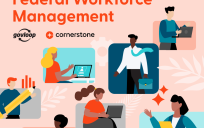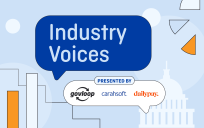This article is an excerpt from GovLoop’s recent guide, “The State of the Workforce: Key Issues Government Managers Face.” Download the full guide here.
In order to compete for top talent, more and more human resources leaders across government are realizing the importance of keeping pace with changes in HR service delivery that will enable them to focus on transforming their employee experience. As they look to redefine the role of HR and find new ways to serve employees, their focus is on automation to streamline and simplify how work gets done across all government departments and agencies.
Today’s forward-thinking HR professionals are embracing compelling shifts that are rooted in private-sector practices, such as boosting employee self-reliance, creating digital experiences and adopting a shared services operating model. However, agencies are faced with the challenge of finding innovative ways to incorporate these shifts into their business model on a wider scale just as their counterparts are doing in the private sector.
To better understand the extent of HR transformation in government and what agencies can do to address the needs and expectations of their employees, GovLoop sat down with three experts from ServiceNow: Gaylan Sankey, HR Transformation Leader; Ryan Mitchell, HR Product Line Sales Manager; and Tim Enright, Product Line Sales Manager, Federal Civilian. At ServiceNow, their teams work closely with government agencies to unlock the potential of HR organizations.
“When an agency makes employee experience a key area of focus, HR can become more of a business partner, as opposed to being bogged down with daily questions about employees’ benefits or paychecks,” Sankey said.
One of the building blocks that HR professionals should focus on is developing more opportunities for employees to manage their own basic information and service needs, Mitchell explained. HR departments can save a lot of time and effort – and frustration – by leveraging automated tools and portals to provide the right information to the right person at the right time. When done effectively, self-service options can reduce the number of cases submitted to HR because employees are empowered to help themselves.
Another key shift taking place in government is the adoption of HR shared services. This isn’t a new concept, but it has evolved well beyond routine transactional activities. The next generation HR shared services model now leverages modern technology, automation and chat to focus on improving self-service through a digital-first approach. For example, we are now seeing HR shared services expand to become the most common provider of new hire onboarding services.
In addition to shared services, IT modernization is central to improving the HR experience governmentwide. But the thought of ripping and replacing older systems with more modern technologies can be cost-prohibitive for agencies with limited budgets.
“Agencies are skinning the entire employee experience with ServiceNow so that they can keep their legacy tools until they can figure out a path forward on those,” Sankey said. “They can still have that one-stop shop for employees that has the look and feel of a modern solution.”
Employees don’t necessarily want to know or have to know how that experience is created. They just want the freedom and ability to get access to what they need when they need it. For example, ServiceNow HR Service Delivery provides a single access point for efficient, personalized HR services and can easily integrate with other cloud and on-premise systems.
“We encourage agencies to look at change,” Mitchell said. “If you’re going to implement new technology, you’re changing. And if you’re going to change, let’s change processes and workflows as well.”
That includes embracing mobile options to deliver services and rethinking how agencies tackle issues such as leave requests and other HR housekeeping items.
“What the government wants to do with the employee experience is create accountability around simple service requests, for example, but also create transparency all the way down to the employee and the manager,” Mitchell said.
When agencies embrace this way of thinking and operating, they create an environment that supports employee engagement, better customer service and a stronger, more productive workforce.






Leave a Reply
You must be logged in to post a comment.